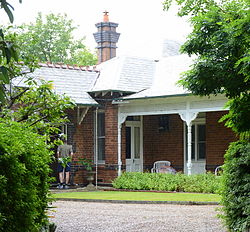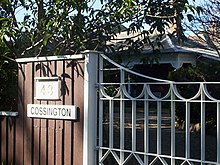
The Victorian Artists Society, which can trace its establishment to 1856 in Melbourne, promotes artistic education, art classes and gallery hire exhibition in Australia. It was formed in March 1888 when the Victorian Academy of Arts and the Australian Artists' Association amalgamated.

The National Gallery of Australia (NGA), formerly the Australian National Gallery, is the national art museum of Australia as well as one of the largest art museums in Australia, holding more than 166,000 works of art. Located in Canberra in the Australian Capital Territory, it was established in 1967 by the Australian Government as a national public art museum. As of 2022 it is under the directorship of Nick Mitzevich.

Wahroonga is a suburb in the Upper North Shore of Sydney, in the state of New South Wales, Australia, 18 kilometres north-west of the Sydney central business district, in the local government areas of Ku-ring-gai Council and Hornsby Shire. North Wahroonga is an adjacent separate suburb of the same postcode.

Ethel Campbell Louise Anderson was an early twentieth century Australian poet, essayist, novelist and painter. She considered herself to be mainly a poet, but is now best appreciated for her witty and ironic stories. Anderson has been described as "a high-profile author, artist, art commentator and emissary for modernism".

Turramurra is a suburb on the Upper North Shore of Sydney, in the state of New South Wales, Australia. It is located 16 kilometres (10 mi) north-west of the Sydney central business district, in the local government area of Ku-ring-gai Council. It shares the postcode of 2074 with the adjacent suburbs of North Turramurra, South Turramurra and Warrawee.

The Norman Lindsay Gallery and Museum is the former residence and farmlet of Australian artist Norman Lindsay. Now an art gallery, tourist attraction and museum located at 14–20 Norman Lindsay Crescent in the Blue Mountains town of Faulconbridge in the City of Blue Mountains local government area of New South Wales, Australia, it was built from 1898 to 1913 by Francis Foy, Patrick Ryan, Lindsay, and the artist's wife, Rose Lindsay. The property, owned by the National Trust of Australia (NSW), is also known as Maryville and Springwood.

Grace Cossington Smith was an Australian artist and pioneer of modernist painting in Australia and was instrumental in introducing Post-Impressionism to her home country. Examples of her work are held by every major gallery in Australia.
Grace Adela Williams Crowley was an Australian artist and modernist painter.
Roy De Maistre CBE was an Australian artist of international fame. He is renowned in Australian art for his early experimentation with "colour-music", and is recognised as the first Australian artist to use pure abstraction. His later works were painted in a figurative style generally influenced by Cubism. His Stations of the Cross series hangs in Westminster Cathedral and works of his are hung in the Tate Gallery, London and in the Art Gallery of New South Wales, Sydney.

Olveston Historic Home is a substantial house and museum in an inner suburb of Dunedin, New Zealand. The house was designed by Ernest George in the Jacobean style in the early 20th century for the Theomin family. When Dorothy Theomin died in 1966, the house, garden and contents were gifted to the city, and are now open to the public. The house is decorated and furnished much as it was when the family lived there, creating a snapshot of upperclass colonial Edwardian life. The Theomins were avid collectors and their art, furniture, weapons and decorative items can be seen throughout the house.
Roland Wakelin was a New Zealand-born Australian painter and teacher.
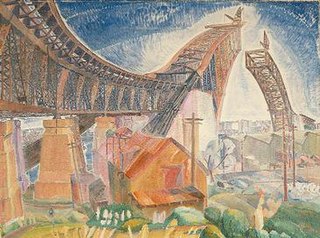
The Bridge in Curve is a painting completed in 1930 by Australian artist Grace Cossington Smith, depicting the Sydney Harbour Bridge during its construction. The work is now considered one of Australia's best modernist paintings, but was rejected from exhibition in 1930.
The Manly Art Gallery and Museum (MAGAM), located in Manly, New South Wales, Australia, was the first metropolitan-based regional gallery in New South Wales and holds an extensive collection of Australian ceramics and 130 works by Antonio Dattilo Rubbo. Since 1982, MAGAM has also been a museum of beach culture and the history of Manly and the Northern Beaches. The permanent collection numbers over 6,000 objects in a range of media including paintings, works on paper, ceramics and museum objects, documents and photographs.

Constance Stokes was an Australian modernist painter who worked in Victoria. She trained at the National Gallery of Victoria Art School until 1929, winning a scholarship to continue her study at London's Royal Academy of Arts. Although Stokes painted few works in the 1930s, her paintings and drawings were exhibited from the 1940s onwards. She was one of only two women, and two Victorians, included in a major exhibition of twelve Australian artists that travelled to Canada, the United Kingdom and Italy in the early 1950s.

Florence Ada Fuller was a South African-born Australian artist. Originally from Port Elizabeth, Fuller migrated as a child to Melbourne with her family. There she trained with her uncle Robert Hawker Dowling and teacher Jane Sutherland and took classes at the National Gallery of Victoria Art School, becoming a professional artist in the late 1880s. In 1892 she left Australia, travelling first to South Africa, where she met and painted for Cecil Rhodes, and then on to Europe. She lived and studied there for the subsequent decade, except for a return to South Africa in 1899 to paint a portrait of Rhodes. Between 1895 and 1904 her works were exhibited at the Paris Salon and London's Royal Academy.
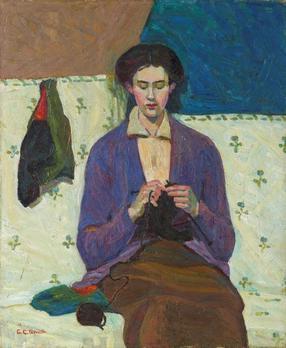
The Sock Knitter is a 1915 painting by the Australian artist Grace Cossington Smith. The painting depicts a woman, believed to be the artist's sister, knitting a sock. It was the first work by Cossington Smith to be exhibited and has been "acclaimed as the first post-impressionist painting to be exhibited in Australia."
The figure is pressed forward onto the picture plane. Tightly constructed. The creamy impasto paint of the backgrounds holds the picture together. The sitter then holds the background together. Like a jigsaw. She is the pattern maker. There are echoing triangles everywhere.

The Chalet is a heritage-listed residence located at 2 Yerton Avenue, Hunters Hill, New South Wales, a suburb of Sydney, Australia. It was designed and built during 1855; and assembled by German carpenters Willhelm Gross, Frederick Lemm, and Jacob Arndt. It is also known as The Bungalow (1867) and The Nora Heysen Studio. The property is privately owned. It was added to the New South Wales State Heritage Register on 10 June 2005.
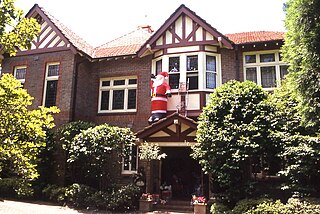
Ingleholme is a heritage-listed residence at 17 Boomerang Street, in the Sydney suburb of Turramurra in the Ku-ring-gai Council local government area of New South Wales, Australia. It was designed by Sir John Sulman and built from 1895 to 1896. It is also known as Ingleholme and Garage. It was added to the New South Wales State Heritage Register on 2 April 1999.
Dobell House is a heritage-listed former residence and now house museum at 47 Dobell Drive, Wangi Wangi, City of Lake Macquarie, New South Wales, Australia. It was built from 1925 to 1970 by Robert Dobell, the father of noted Australian artist, William Dobell. The house is also known as Allawah and was added to the New South Wales State Heritage Register on 3 February 2017.

Brett Whiteley House is a heritage-listed arts and crafts studio and residence in Lavender Bay, New South Wales, Australia. It was built during 1905 by Henry Green. It is also known as Brett Whiteley House and Visual Curtilage and Lochgyle. It was added to the New South Wales State Heritage Register on 23 March 2018.
